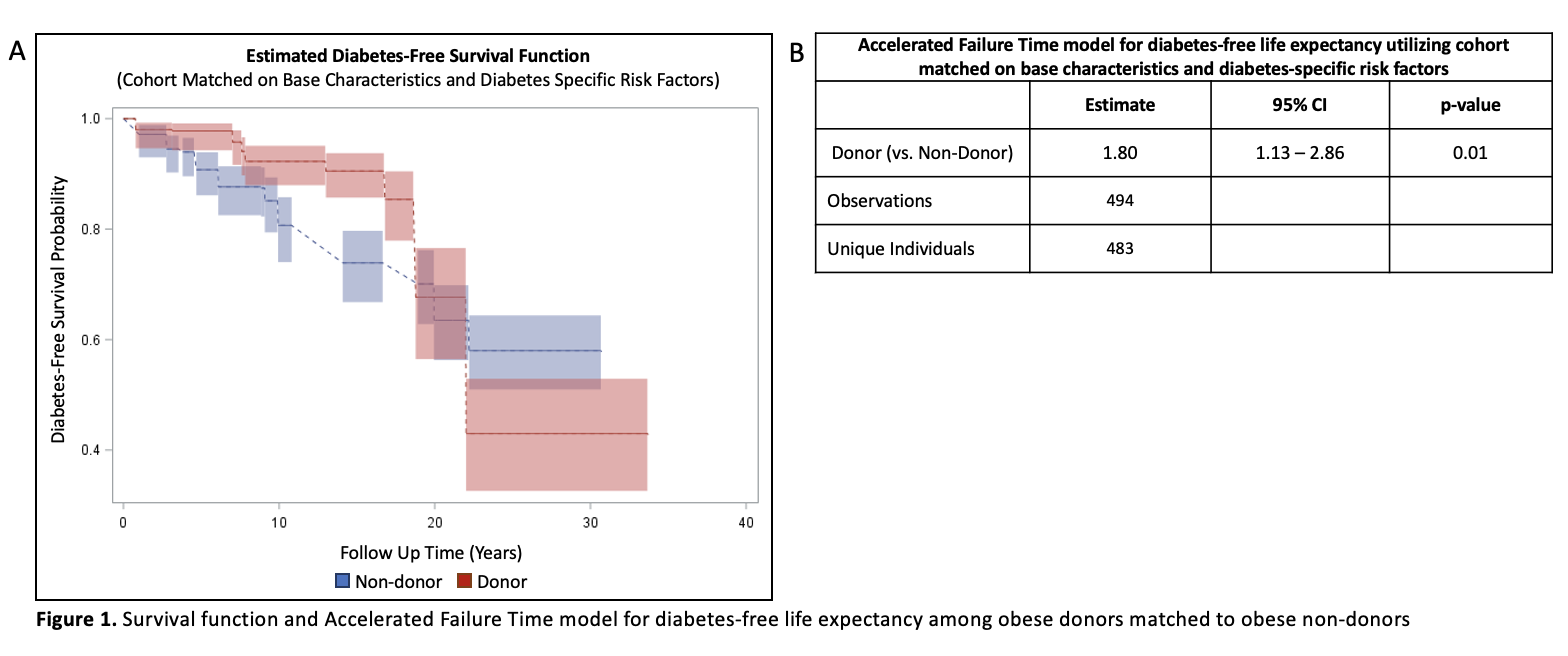Evaluation of Diabetes-Free Life Expectancy Among Living Kidney Donors and Non-Donors with Obesity: A Longitudinal Cohort Study
1University of Alabama at Birmingham, Birmingham, AL, 2Mayo Clinic, Rochester, MN, 3Hennepin County Medical Center, Minneapolis, MN, 4UCSF Medical Center, San Francisco, CA, 5Johns Hopkins University, Baltimore, MD
Meeting: 2022 American Transplant Congress
Abstract number: 99
Keywords: Donation, Obesity, Outcome
Topic: Clinical Science » Kidney » 39 - Kidney Living Donor: Long Term Outcomes
Session Information
Session Name: Kidney Living Donor: Long Term Outcomes
Session Type: Rapid Fire Oral Abstract
Date: Sunday, June 5, 2022
Session Time: 5:30pm-7:00pm
 Presentation Time: 6:10pm-6:20pm
Presentation Time: 6:10pm-6:20pm
Location: Hynes Room 206
*Purpose: The growing end stage kidney disease burden paired with substantial rates of obesity in the United States (US) has prompted increased approval of obese living kidney donors. Compared to non-obese living donors, obese living donors have demonstrated higher rates of diabetes, but risk of diabetes attributable to the donation event itself remains unknown. The purpose of this study was to evaluate diabetes-free life expectancy among obese living kidney donors compared to obese non-donors.
*Methods: In this longitudinal cohort study utilizing multicenter data from 58 US transplant centers, Scientific Registry of Transplant Recipients, and 2 US longitudinal cohort studies (Coronary Artery Risk Development in Young Adults (CARDIA) and the Atherosclerosis Risk in Communities (ARIC)), adult obese living kidney donors (1976-2020) were matched to non-donors on base characteristics (age, sex, race, body mass index, systolic and diastolic blood pressure) and diabetes-specific risk factors (family history of diabetes and impaired fasting glucose). Non-parametric survival methods and Accelerated Failure Time models were utilized to evaluate diabetes-free life expectancy.
*Results: Among the total 4447 participants, 2102 (47%) were living donors and 2345 (53%) non-donors. Within the cohort matched on base characteristics and diabetes-specific risk factors, 9% (22/247) of donors and 26% (63/247) of non-donors developed diabetes over a median follow-up time of 8.6 (interquartile range (IQR):5.4-12.9) and 14.4 (IQR: 6.1-21.1) years, respectively (log rank p=0.01; Figure 1A). Living donors were estimated to live diabetes-free 1.8 times longer than non-donors (estimate 1.80; 95% CI: 1.13-2.86, p=0.01; Figure 1B).
*Conclusions: Obese living kidney donors were estimated to live significantly longer diabetes-free compared to obese non-donors, suggesting there was no increased risk of diabetes attributable to donation in this population.
To cite this abstract in AMA style:
Killian C, Reed R, McLeod M, MacLennan P, Kumar V, Brooks S, Maynor A, Stanford L, Baker G, Schinstock C, Silkensen J, Roll G, Segev D, Orandi B, Lewis C, Locke J. Evaluation of Diabetes-Free Life Expectancy Among Living Kidney Donors and Non-Donors with Obesity: A Longitudinal Cohort Study [abstract]. Am J Transplant. 2022; 22 (suppl 3). https://atcmeetingabstracts.com/abstract/evaluation-of-diabetes-free-life-expectancy-among-living-kidney-donors-and-non-donors-with-obesity-a-longitudinal-cohort-study/. Accessed December 15, 2025.« Back to 2022 American Transplant Congress

